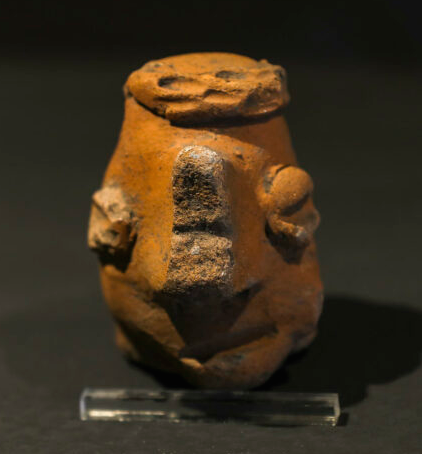Excavation of a 2,000-year-old cemetery provides a glimpse into Ecuador’s distant past
By Fernando Gimeno
The discovery of an ancient pre-Columbian cemetery in Quito is helping to shed light on human populations that settled in that region around 2,000 years ago.
Ceramic vessels and stone-carved decorative objects are among the more than 5,000 pieces found at the site, which is located in what today is the Llano Chico area of Quito’s north side and had been buried until now under farmland.

One of the stone-carved decorative objects found at the prehistoric site in Quito.
Among the finds made there by archaeologists from Quito’s Metropolitan Institute of Heritage (IMP) were a score of tombs, some of which feature burial offerings containing objects these people used in their daily lives.
The cemetery now constitutes one of the main archaeological sites in the Ecuadorian capital, Andres Mosquera, one of IMP’s archaeologists, said.
Located 80 centimeters (just under three feet) below ground, the cemetery had been covered by a layer of ash from an eruption of the Pichincha Volcano.
It is made up of one-meter-high shafts in the shape of bells or trapezoids that served as tombs, food storage areas or landfills. Although more than 5,000 pieces were recovered, only 128 were fully intact, Mosquera said.
He added that those objects that were at least 75 percent preserved have been registered in the government’s databases.
Inside the tombs, the archaeologists observed that the dead bodies had been buried in a bent position, which is characteristic of pre-Columbian cemeteries. But they found no evidence that the bodies – including adults no more than 40 years old and children – had been covered with any type of fabric.
The cemetery is particularly notable for the differences in the funeral offerings found, a feature that archaeologists say reveals the social disparities of that society.
While some tombs had a plentiful number of vessels and ornamental objects, others were very austere.
“This is very important considering that this find corresponds to the period of Regional Development, which theoretically was a period in which political hierarchies emerged,” the specialist said. “And they were very marked hierarchies, with stratified political systems, especially on the coast.”
Another sign of social differentiation was seen in the artificial cranial deformation of some of the skeletons, according to Mosquera.
He said the craniums of small children of the social elite were intentionally lengthened as physical proof of their superior status.
The expert also noted that this was a traditional practice of other contemporary cultures in what is today Ecuador’s coastal region, including La Tolita and Jama Coaque.
“Without a doubt, what we’re finding here in Quito reflects the influence of the La Tolita culture,” Mosquera said.
___________________
Credit: La Prensa Latina





















